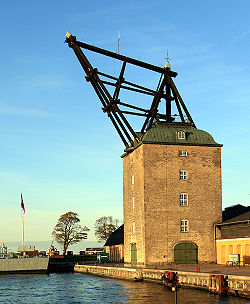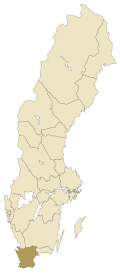
Back بوابة:الدنمارك Arabic Portál:Dánsko Czech Portal:Danmark Danish Portal:Dänemark German Portal:Danimarka DIQ Portal:Dinamarca Spanish Portail:Danemark French Portal:Dinamarca Galician Պորտալ:Դանիա Armenian Portale:Danimarca Italian
Welcome to the Denmark Portal! | ||||

|

|

| |
Denmark is the smallest and southernmost of the Nordic countries. Unified in the 10th century, it is also the oldest. Located north of its only land neighbour, Germany, south-west of Sweden, and south of Norway, it is located in northern Europe. From a cultural point of view, Denmark belongs to the family of Scandinavian countries although it is not located on the Scandinavian Peninsula. The national capital is Copenhagen.
Denmark borders both the Baltic and the North Sea. The country consists of a large peninsula, Jutland, which borders Schleswig-Holstein; many islands, most notably Zealand, Funen, Vendsyssel-Thy, Lolland, and Bornholm; and hundreds of minor islands often referred to as the Danish Archipelago. Denmark has historically controlled the approach to the Baltic Sea, and those waters are also known as the Danish straits.
Denmark has been a constitutional monarchy since 1849 and is a parliamentary democracy. It became a member of the European Economic Community (now the European Union) in 1973. The Kingdom of Denmark also encompasses two off-shore territories, Greenland and the Faroe Islands, both of which enjoy wide-ranging home rule. The Danish monarchy is the oldest existing monarchy in Europe, and the national flag is the oldest state flag in continuous use.
Selected biography

Karen von Blixen-Finecke (April 17, 1885 – September 7, 1962), née Dinesen, was a Danish author also known under her pen name Isak Dinesen. Blixen wrote works both in Danish and in English. She is best known, at least in English, for her account of living in Kenya, Out of Africa, and a film based on one of her stories, Babette's Feast.
Daughter of Ingeborg Westenholz Dinesen, and the writer and army officer Wilhelm Dinesen, and sister of Thomas Dinesen, she was born into a Unitarian aristocratic family in Rungsted on the island of Zealand, in Denmark, and was schooled in art in Copenhagen, Paris, and Rome. She began publishing fiction in various Danish periodicals in 1905 under the pseudonym Osceola, the name of the Seminole Indian leader, and possibly inspired by her father's connection with American Indians. From August 1872 to December 1873, Wilhelm Dinesen had lived among the Chippewa Indians, in Wisconsin, where he fathered a daughter, who was born after his return to Denmark.
Recently selected: Bertel Thorvaldsen - Rasmus Rask - Piet Hein
Selected picture

Selected article
Scanian was previously classified as a regional language by SIL International, but before the latest update, the Swedish representative to ISO/TC-37, the technical committee overseeing ISO 639, required that Scanian be removed from the ISO/DIS 639-3, the draft just prior to the final draft FDIS, or a positive vote from Sweden would not be forthcoming. The prior identifier ISO 639-3:scy, as used in the Ethnologue 15th edition, is reserved for Scanian, and may become active again if a request is submitted to have it reinstated during the annual review process. Within the previous SIL International classification of Scanian were the dialects in the province of Scania, some of the southern dialects of Halland (halländska in Swedish), the dialects of Blekinge (blekingska in Swedish) and the dialects of the Danish island of Bornholm (bornholmsk in Danish).
Selected place
Owing to its natural harbour and its strategic position in the Baltic Sea, Rønne has an interesting history coming under German and Swedish influence during its development as a herring fishing port. Today, with its quaint cobbled streets, half-timbered houses and interesting museums, it attracts visitors mainly from Denmark, Germany, Sweden and Poland.
Categories
Denmark topics
Things you can do
- Expand stubs:
Geography stubs · People stubs · Denmark stubs in general
Help us extend these stubs and make them real articles!
- Categorize:
Help us categorize Denmark-related articles
- WikiProjects:
Have a look at WikiProject Denmark, WikiProject Faroe Islands, WikiProject Greenland and WikiProject Norse history and culture
- Noticeboard:
Have a look at the Danish Wikipedians' notice board
- Geotag:
Find coordinates for these locations and tag them: articles missing geocoordinate data
Related portals
Northern Europe
Other countries
Associated WikiMedia
The following Wikimedia Foundation sister projects provide more on this subject:
-
Commons
Free media repository -
Wikibooks
Free textbooks and manuals -
Wikidata
Free knowledge base -
Wikinews
Free-content news -
Wikiquote
Collection of quotations -
Wikisource
Free-content library -
Wikispecies
Directory of species -
Wikiversity
Free learning tools -
Wikivoyage
Free travel guide -
Wiktionary
Dictionary and thesaurus
© MMXXIII Rich X Search. We shall prevail. All rights reserved. Rich X Search












